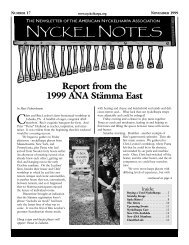Download Number 2 - American Nyckelharpa Association
Download Number 2 - American Nyckelharpa Association
Download Number 2 - American Nyckelharpa Association
You also want an ePaper? Increase the reach of your titles
YUMPU automatically turns print PDFs into web optimized ePapers that Google loves.
Nyckel Notes Oct 1995 4<br />
Tierpspolskan (excerpt)<br />
& # 4 3<br />
≤<br />
j œ<br />
≥<br />
œ<br />
≤<br />
œ.<br />
≥<br />
œ œ .<br />
≤<br />
œ<br />
≥<br />
œ œ œ œ ≤ ≥<br />
. œ œ.<br />
≤<br />
œ<br />
œ œ.<br />
œ œ.<br />
œ<br />
œ.<br />
œ œ.<br />
œ œ.<br />
œ<br />
3<br />
Gärdebylåten (excerpt)<br />
& # ≥ ≤<br />
# 2 4 œ œ œ œ œ œ œ œ<br />
≤<br />
≥<br />
œ œ œ œ œ œ<br />
≥<br />
œ œ œ œ<br />
œ œ œ œ ≤ œ œ œ œ<br />
Byggnan (excerpt)<br />
& b 4 3 œ ≥ œ œ œ<br />
œ ≤ œ œ œ<br />
≥ œ<br />
œ œ œ<br />
œ ≤<br />
œ œ œ<br />
≥ œ<br />
œ œ œ<br />
œ ≤<br />
œ œ œ<br />
The bow should touch the string you’re playing about<br />
halfway between the bridge and the end of the<br />
keybox. An excellent way to practice moving the<br />
bow in a straight line and keeping it at the proper<br />
place on the string is to play in front of a mirror. Find<br />
a comfortable playing position, then watch your bow<br />
as you play. Play open strings as a start: without<br />
worrying about what the left hand is doing, you’ll<br />
have more concentration available to watch the bow.<br />
Most people play with the bow leaning (rotated along<br />
its axis) away from the bridge. This gives you better<br />
control of the hair’s force against the string, and<br />
helps keep the bow from bouncing.<br />
Moving from string to string<br />
Of the nyckelharpa’s four strings, you play one at a<br />
time or, occasionally, two. To move from one string<br />
to another, your arm changes its position and your<br />
wrist and hand change the angle of the bow. This is<br />
easier than it sounds, and becomes one uniform set<br />
of motions rather than individual conscious actions.<br />
You can practice this while you’re making the bow go<br />
straight, too. Move from string to string and learn<br />
where the bow should be to play only that string and<br />
not its neighbors.<br />
Articulating notes with the bow<br />
Many Swedish fiddlers and nyckelharpa players play<br />
with very light bow force but apply extra force (from<br />
the right hand’s fingers) at the beginning of each<br />
note. This gives a light, singing tone and accents the<br />
rhythm; it also helps with string crossings - notes on<br />
different strings played with the same bow stroke.<br />
The muscle skills to do this are subtle and take<br />
some development. If you’re relatively new to bowed<br />
instruments, they’ll take some time. Don’t worry too<br />
much about it, but experiment with bow force, how it<br />
affects the sound you make, and how you can use<br />
extra force to mark the start of each note.<br />
Bowing patterns<br />
It is with the bow that you play the rhythm of a tune,<br />
thereby lifting up the dancers and moving them<br />
around the floor. Playing fluidly and rhythmically<br />
makes the difference between a tune and a random<br />
bunch of notes. Slurring - playing multiple notes on<br />
the same bow stroke - is a powerful tool for rhythmic<br />
expression, based on when the slurs occur and<br />
which notes are slurred.<br />
There are some basic bowing patterns in Swedish<br />
music. We’ll look here at two of the most common.<br />
The polska bowing turns up in eighth-note polskas:<br />
hambo, Uppland (Viksta) bondpolska, Boda polska,<br />
to name a few. The bow "dances" in time to the
















